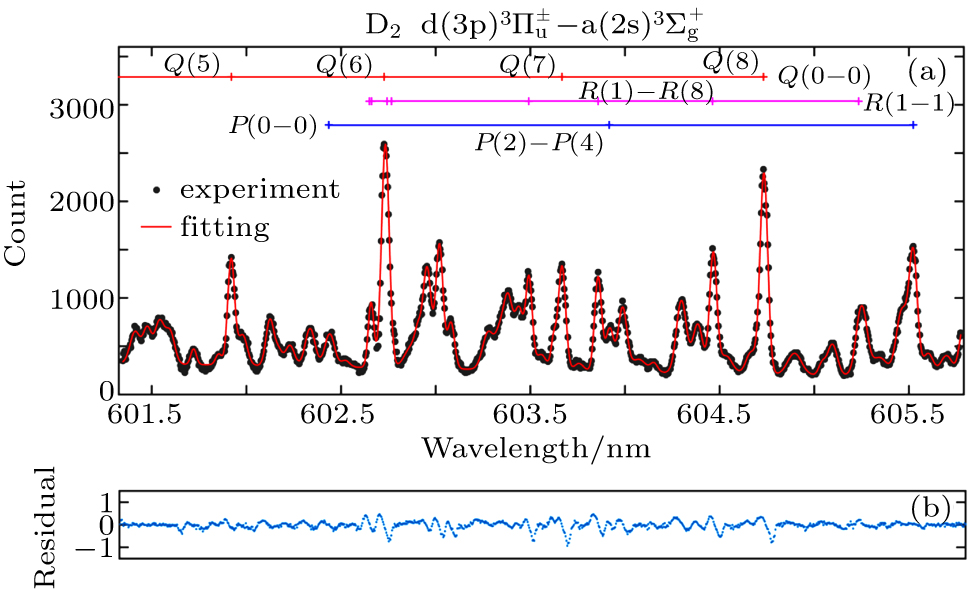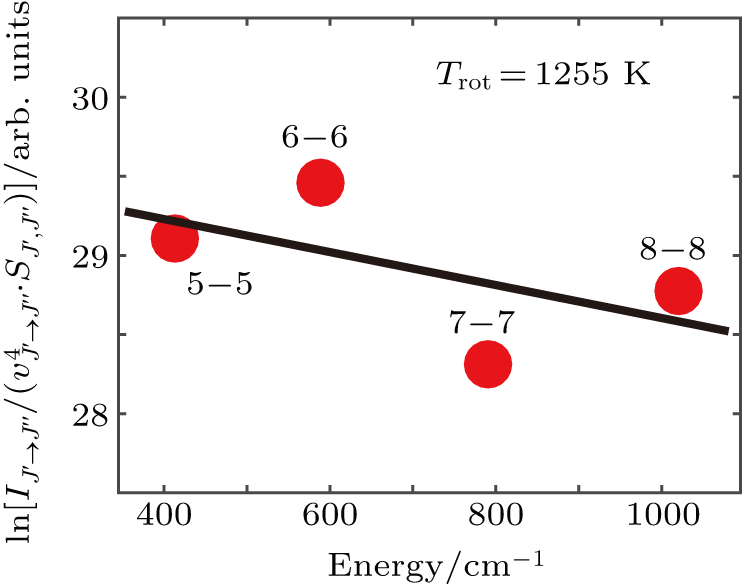† Corresponding author. E-mail:
Project supported by the National Natural Science Foundation of China (Grant No. 11805234).
Based on neon gas puffing, an active feedback control of H-mod plasma divertor detachment experiment was successfully operated on the EAST tokamak. During the feedback control discharge, the plasma was detached by puffing neon gas and the strike point splitting phenomenon on divertor target was also clearly observed by divertor probes diagnostic. In boundary region, many neutral particle processes (atom and molecule) were happened and accompanied by their emission spectra under the detachment discharge. By studying these emission spectra, it is helpful for us to understand the role of atoms and molecules in boundary recycling, which is important for studying the physical mechanism of divertor detachment. For the Fulcher-α system (

One of the most critical issues for high power and long pulse steady-state H-mod plasma operation on the EAST is how to deal with the high divertor power, particle fluxes and related plasma–wall interaction (PWI). It is also important for the future International Thermonuclear Experimental Reactor (ITER) and the China Fusion Engineering Test Reactor (CFETR). Currently, the divertor detachment operation offers one of the most attractive means of addressing the heat load on divertor plates, which has been used on many fusion devices and even will be used on the ITER and the CFETR. Under the detachment, there are many neutral particle processes (atoms and molecules) in the boundary, which could be studied to acquire the boundary recycling information. It would be helpful for us to understand the physical mechanism of divertor detachment discharge. The hydrogen molecules and its isotopes in the edge plasma of a tokamak are of high interest under the detachment in current research. Because they affect the energy and particle balances in the edge plasma, participating in reactions of excitation, ionization, dissociation and recombination. The explanations of the role of the complicate molecular processes are still insufficient, so it is necessary to observe and study the vibrationally excited molecule emission spectrum to understand the effect of them in the boundary recycling at the edge region directly. The emission spectra of hydrogen molecule isotopes are distributed in the entire visible band and blended with their atom lines of the Balmer series. Because their emission spectra have the rotational structures, it is necessary to analyze the molecular spectra with the electron-vibrational-rotational transitions in studying the processes in edge plasmas, and it has been carried out on some tokamaks (TEXTOR, DIII-D, JET, T-10 etc).[1–5] In previous studies, much attention paid to the molecular spectra is about the proportion to the total flux in the recyling,[2–10] because the charged particles of the total flux coming into the plasma could be significantly underestimated when atomic component is considered to be the only item.
However, the similar works have not been performed on the EAST tokamak. In last campaign (2018), an active feedback control divertor detachment experiment by puffing neon gas was successfully operated for the first time on the EAST. During detachment discharge, the deuterium molecule emission spectra of the Fulcher-α system (



The paper is organized as follows. The experimental setup and diagnostic performance are introduced in Section
The EAST is a fully superconducting tokamak which can create a spiralling magnetic field configuration with an ITER-like D-shaped cross section. The range of the major radius R is 1.7–1.9 m, the minor radius a is 0.4–0.45 m, the triangularity δ is 0.4–0.7 and the elongation k is up to 1.9. The plasma current Ip can be 1 MA with the toroidal magnetic field currently operated in the range of Bt = 1.2–3.5 T. A flexible PF control system with separate power supply for each PF coil is used to accommodate both upper/lower single null (USN/LSN) and double null (DN) divertor configurations. The lower and upper divertors were covered by graphite tiles. In recent upgrade, the upper graphite divertor has been replaced with an ITER-like tungsten (W) monoblock divertor, by which the capability of total auxiliary heating has been enhanced, with the source power over 20 MW with rf heating dominant. The OSMA system is used to observe the atomic and molecular emission spectra in boundary region on the EAST. It consists of an SP750 spectrometer and a ProEM Electron-Multiplying charge coupled device (EMCCD) 1024B camera. The focal length of the spectrometer is 750 mm, which features a triple grating turret and triple indexable gratings (2400 g/m@600 nm, 1200 g/m@500 nm, 1200 g/m@300 nm). It includes a direct digital grating scan mechanism with full wavelength scanning capabilities in visible band. The ProEM EMCCD is a back-illuminated, thermoelectrically cooled pixels (1024×1024) CCD with the size of 13 μm × 13 μm, which has a dynamic range of 16 bits. The EMCCD is cooled below −75 °C and has a lot of advantages, such as high sensitivity, extremely low etaloning, baseline active stability engine, EM and non-EM modes for lowest noise and the best linearity. The slit width of the spectrometer can be adjusted from 10 μm to 3000 μm. The schematic diagram of the experiment is shown in Fig.
In the present work, the analyzed divertor detachment discharge was conducted in upper single null divertor configuration with top W divertor with ion gradient drift B × ∇ B ↑, and it was successfully operated by neon gas puffing feedback control in NBI dominated H-mod plasma discharge in 2018 campaign, also utilizing the divertor particle flux control module. It shows that neon is one of the most suitable impurity species for increasing edge radiation without significant decrease of core plasma performance compared with the argon and nitrogen on the EAST.[16,17] For the top W divertor of the EAST at the present time, it is not very good for impurity screening, so the neon seeding was performed using the mixture with D2, and the ratio of Ne to D2 was selected from 5% to 20%. The discharge conditions are presented in Fig.
 | Fig. 2. Discharge conditions of the active feedback control of divertor detachment experiment shot #80435 on the EAST. |
Figure
Under the detachment experiment, the deuterium molecular emission spectra in the wavelength range from 601 nm to 606 nm (Fulcher-α system, 






 |
 | Fig. 4. Fitting of the spectra of deuterium molecular emission spectra of the Fulcher-α system (601–606 nm). |
For high resolution and good signal-to-noise ratio of D2 emission spectra, the main fitting errors are from the blending of spectral lines of other branches for the complexity of the molecular spectra and part of unrecognized impurity spectral lines in this band for kinds of impurities in plasma boundary.
Due to the 2400 g/m grating used for acquiring high resolution, the scan range of the OSMA was only 5 nm (601–606 nm) in one discharge. Therefore, only the spectral lines Q(5)–Q(8) in the Q(0–0) band were observed and used for the analysis under the absolutely same discharge parameters. Under the detachment, the temperature Te in the boundary was less than 5 eV, which could not provide diagnostics on the EAST, so we needed to use other methods to acquire the information of temperature data based on observed deuterium molecular emission spectra. In this work, the rotational temperature of the ground 

 |











During the divertor detachment discharge, an interesting phenomenon was also observed, and the measured D2 emission spectra at three time points (t = 4 s, 4.5 s, 5.5 s) were compared, as shown in Fig. 



An active feedback control of H-mode divertor detachment by neon gas puffing experiment was operated and succeeded for the first time on the EAST tokamak. By neon gas puffing, the plasma was successful detached, and the strike point splitting was clearly observed by diagnostic of divertor probes on the upper out divertor region at D port and O port. During the detachment discharge, the emission spectra of deuterium molecular of the Fulcher-α system (


| [1] | |
| [2] | |
| [3] | |
| [4] | |
| [5] | |
| [6] | |
| [7] | |
| [8] | |
| [9] | |
| [10] | |
| [11] | |
| [12] | |
| [13] | |
| [14] | |
| [15] | |
| [16] | |
| [17] | |
| [18] | |
| [19] | |
| [20] | |
| [21] | |
| [22] |






